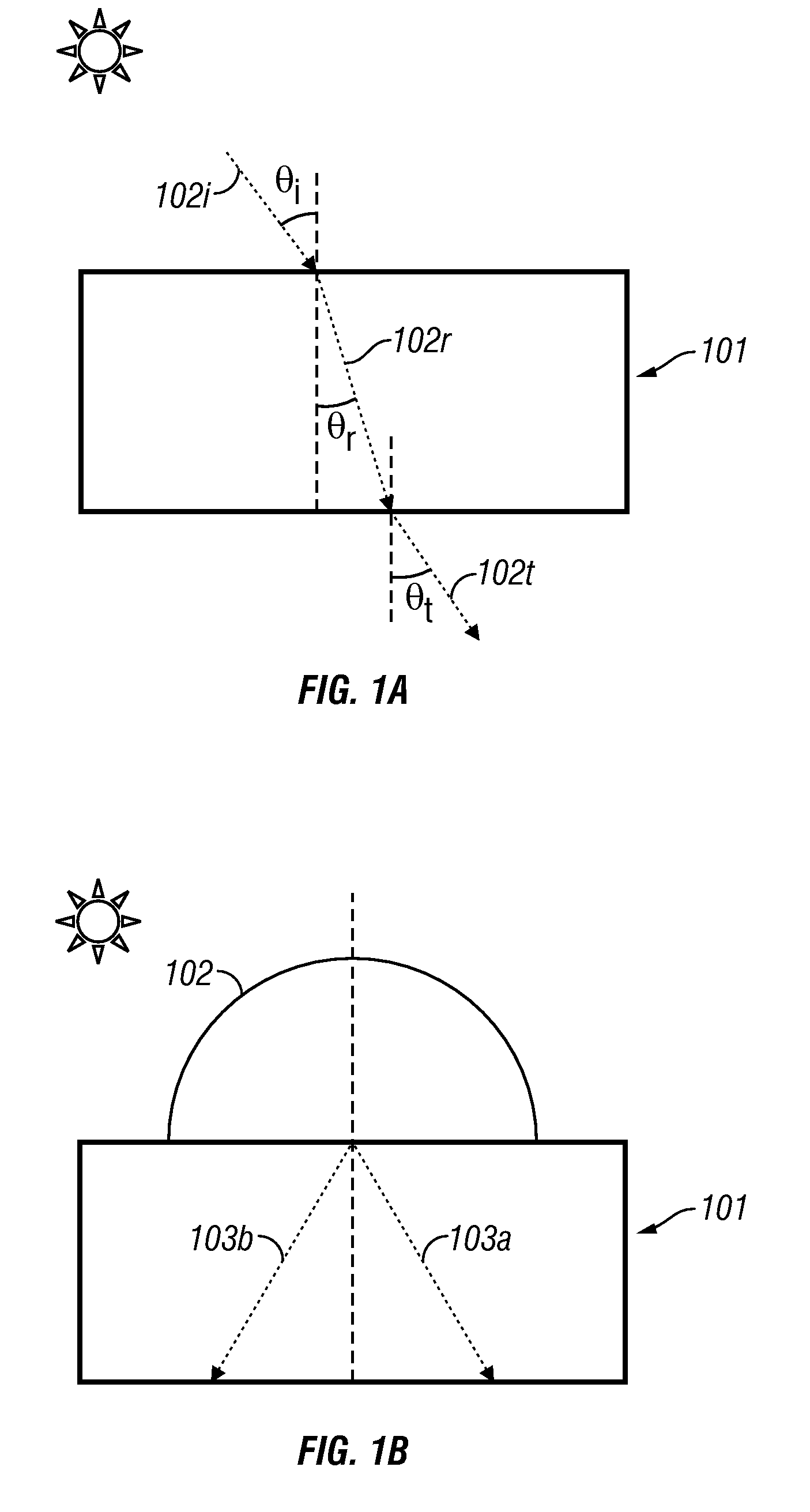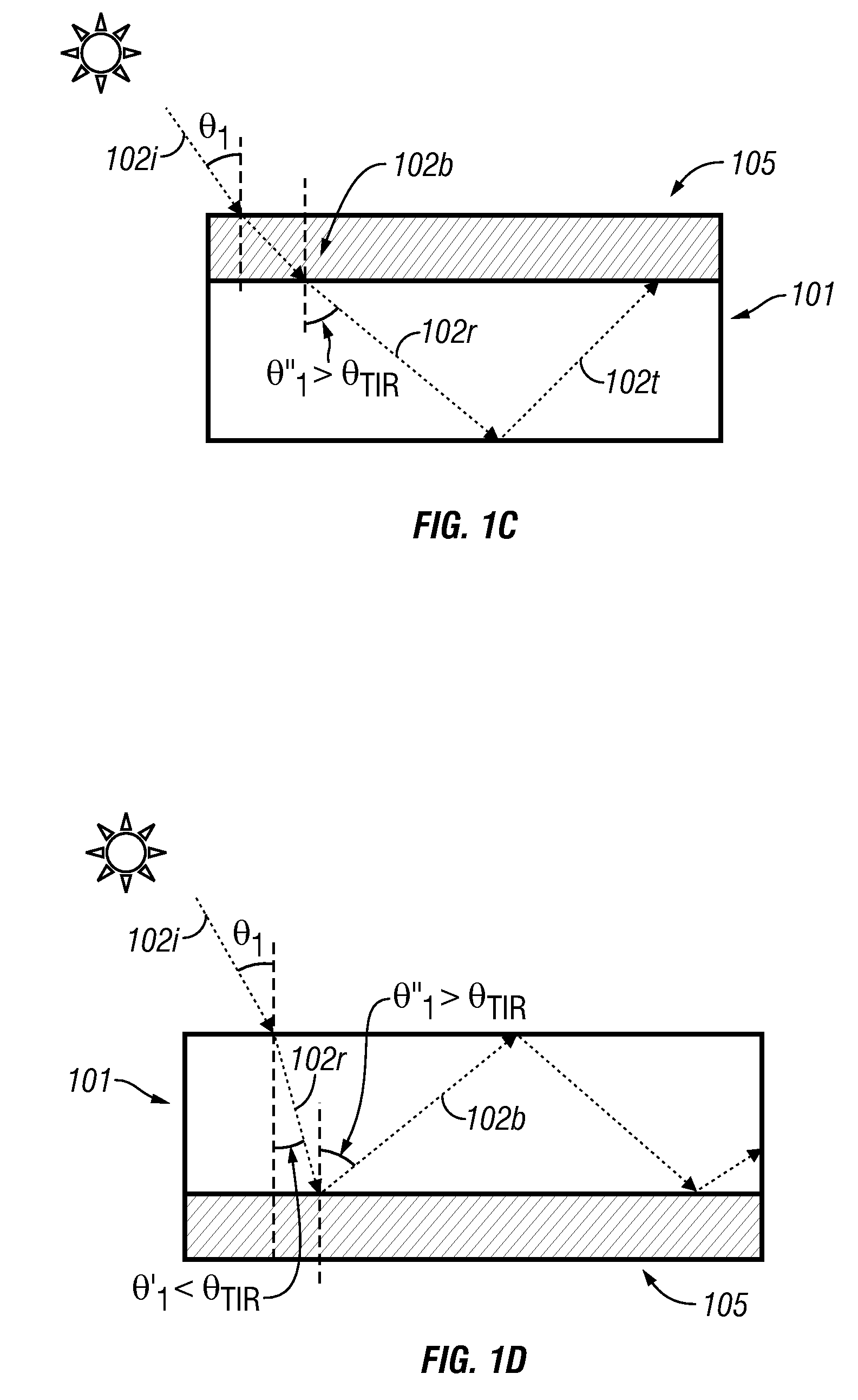Thin film holographic solar concentrator/collector
a solar concentrator and film technology, applied in the field of solar power, can solve the problems of affecting the supply of fossil fuels, affecting the efficiency of diffraction, and a considerable burden on fossil fuels, and achieve the effect of increasing diffraction efficiency
- Summary
- Abstract
- Description
- Claims
- Application Information
AI Technical Summary
Benefits of technology
Problems solved by technology
Method used
Image
Examples
embodiment 400
[0071]FIG. 4A shows one method of fabricating an embodiment 400 comprising a volume transmission hologram. The method comprises disposing a photosensitive plate, film or layer 405 on the upper surface of a light guide 401. As described above, the photosensitive plate, film or layer 405 may be laminated or adhered to the light guide 401, for example, by an adhesive layer. This adhesive layer may be index-matched to the light guide 401. In other embodiments, the photosensitive material is coated on the light guide 401. In certain embodiments, the photosensitive plate, film or layer 405 may be referred to as a hologram recording material. The photosensitive plate, film or layer 405 may comprise photographic emulsions, dichromated gelatin, photoresists, photothermoplastics, photopolymers, photochromics, photorefractives, etc. In some embodiments, the hologram recording material may comprise a layer of silver halide or other photosensitive chemical. Diffractive features may be formed in ...
embodiment 500
[0075]FIG. 5A shows a method of fabricating an embodiment 500 comprising reflection holograms. In this embodiment, the method comprises disposing a photosensitive plate, film or layer 505 on a bottom surface of a light guide 501. The photographic plate, film or layer can be coated on or laminated to the bottom surface of the light guide 501. As described above with reference to FIG. 4A, an adhesive can be used to join the photosensitive plate, film or layer to the light guide 501. The reference laser source 508 is disposed rearward to the light guide 501 such that the reference beam is incident on the bottom surface of the light guide 501. As described above, the reference prism 506 can be used to couple the reference beam at steep angles (for e.g. θ″) to produce a beam that is a guided mode of the light guide 501. A light source 507 is disposed forward of the light guide 501 such that the object beam is incident on the upper surface of the light guide 501. The interference pattern ...
embodiment 900
[0081]For every embodiment of the stacked composite light collector described above, the light collection efficiency can be further increased by designing each light turning element to capture or collect light in different angular cones as well as light in different spectral regions. This concept is described in detail below. In the embodiment 900 shown in FIG. 9, multiple light guide layers 901, 902, 903, 904, 905 and 906 are stacked together to form a composite light collecting structure. PV cells 913 can be disposed laterally with respect to the composite light collecting structure as shown in FIG. 9. Each light guide layer 901 through 906 further comprises a light turning element comprising diffraction features or holograms 907 through 912 as shown in FIG. 9A. The different light turning elements 907 through 912 are configured to capture light incident on the light collector from the surrounding medium (e.g. air) at different angles. For example, in one embodiment light turning ...
PUM
 Login to View More
Login to View More Abstract
Description
Claims
Application Information
 Login to View More
Login to View More - R&D
- Intellectual Property
- Life Sciences
- Materials
- Tech Scout
- Unparalleled Data Quality
- Higher Quality Content
- 60% Fewer Hallucinations
Browse by: Latest US Patents, China's latest patents, Technical Efficacy Thesaurus, Application Domain, Technology Topic, Popular Technical Reports.
© 2025 PatSnap. All rights reserved.Legal|Privacy policy|Modern Slavery Act Transparency Statement|Sitemap|About US| Contact US: help@patsnap.com



